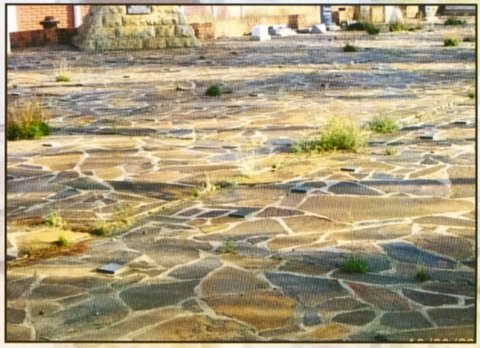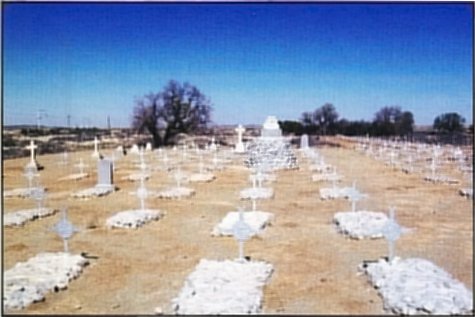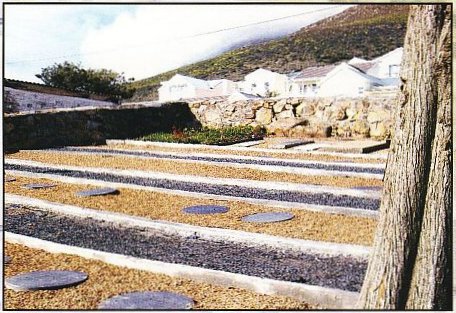

 The South African
The South African
Following complaints about the condition of the graves of British casualties in South Africa, mainly from the South African War (Anglo-Boer war of 1899 to 1902), and research compiled by Steve Watt, In Memoriam: Roll of Honour Imperial Forces Anglo-Boer War 1899-1902 (University of KwaZulu-Natal 2000), an agreement was signed between the governments of South Africa and the United Kingdom and Northern Ireland, transferring the responsibility for these graves to the Commonwealth War Graves Commission. This agreement was signed on 23 September 2005. This was followed by the signing of a Memorandum of Understanding between the South African-Agency and the South African Heritage Resources Agency (SAHRA), whereby the South African Agency assumed responsibility for the graves early in 2006.

Preparation
A budget accepted by the United Kingdom's Ministry of Defence was based on a feasibility study done by the South African Agency whereby 220 sites commemorating ten or more casualties, unless the site had some historical significance, would be renovated over a period of five years. Work was scheduled to commence in the 2006/7 year, with 35 sites being renovated, followed by 55 sites in each year from 2007/8 to 2009/10, and a final ten being restored in 2010/11. Once renovated, ten sites would receive intensive maintenance, 75 regular maintenance, 100 irregular maintenance and 35 would not receive any maintenance.
KwaZulu-Natal battlefields
To achieve the renovation of the required number of sites per year, two additional Technical Assistants were appointed on a two-year contract basis. To ensure that an acceptable standard was established, the two technical assistants worked together when the project was launched in March 2006. The feasibility study indicated that the sites in KwaZulu-Natal would require the least effort to bring them up to standard, so the project started with the sites in and around Ladysmith. This included the Ladysmith Cemetery with its two plots, Chievely Cemetery, Bruntville Cemetery at Mooi River, Ambleside and Clouston Kop near Colenso and numerous smaller sites in the area. Also included was the Armoured Train site near Frere, which commemorates only four casualties but is also the site where Winston Churchill was captured. While the Commonwealth in the Fort Napier cemetery was maintained, the rest of the cemetery was not. South African War (Anglo-Boer War) graves are scattered across the cemetery, so it was decided that all these, graves should be renovated and the entire cemetery would be maintained. This was contracted out to a local artisan.
Once the KwaZulu-Natal sites had been renovated a Memorandum of Understanding was signed between the Agency and the KwaZulu-Natal Heritage Organsiation, AMAFA, to assume responsibility for the maintenance of these sites. These included Spioenkop, Onderbroekspruit, Clousten, Ambleside, Chieveley, Elandslaagte Battleridge and Naval, Frere, Caesar's Camp, Wagon Hill and Bruntville, Mooi River.
The Free State and Cape sites
The technical assistants then split up, the second technical assistant moving into the Free State where sites such as Harrismith, Bethlehem, Winburg, Bethulie, Dewetsdorp, Senekal, Ficksburg, Hoopstad and Bothaville were renovated along with a number of smaller sites. At the same time the Commonwealth War Grves Commission's contractor in Cape Town was tasked with the renovation of the British Plot in the Maitland cemetery, which was conveniently adjacent to the Commonwealth plot. The latter turned out to be a bit of a challenge due to a mole problem and the foundations had to be dug one and a half metres deep. Work continued to progress and sites in the Eastern Cape and Mpumalanga were renovated. Horticulture, similar to that in the Commonwealth plot, had been established in the Maitland Cemetery.
By mid-2009 a total of 87 sites had been renovated. These represented those cemeteries that were initialiy identified as the 'easy sites'. Notwithstanding this, the project was about 18 to 24 months behind schedule, mainly due to the influence of the weather and underestimation of the work involved. At the beginning of 2010, the overalI total was reviewed and the initial number of 220 was adjusted to 177 of which 93 had been completed. The focus now shifted to the outstanding sites, mainly in the Free State (24) Northern Cape (17) and North West Province (17). This revised approach necessitated abnormal measures, and the Commonwealth contractor in Cape Town was requested to survey the outstanding sites in Cape Town and Laingsburg and submit quotations, which were accepted and he was tasked to renovate the sites.

The outlying sites of the Northern Cape were the first priority, with the British Garden of Remembrance in the De Aar Old Cemetery on top of the list. The plot had been completely vandalised with all headstones damaged as well as the very neat floor. This required extended work and the entire floor had to be lifted and re-laid while the damaged headstones were repaired as best as possible. This took the best part of eight weeks. The sites at Deelfonfein, Colesberg and Noupoort were all in a fair condition and were renovated within a reasonable timeframe. Being out of the way, most of the cast iron grave markers were still in place at the Deelfontein Cemetery. The West End Cemetery had been renovated for the centenary commemoration of the South African War (Anglo-Boer War) so it was in fair condition with only a number of granite plaques missing. With the assistance of local historians, the missing names were identified and new plaques manufactured and replaced. However the West End Garden of Remembrance was in poor condition, with most of the marble and granite headstones damaged, while just about all the cast iron/brass plaques on the wall behind the main memorial had been stolen. Once again, with the help of local historians, we were able to identify the names and erect a new granite panel with the names on the plaques that had been stolen. The remaining smaller sites in the Northern Cape were soon renovated.
In Kimberley, various small plots of graves in the Gladstone Cemetery were renovated, but we need to return to the cemetery to identify those graves that no longer have grave markers. Although not the responsibility of the Agency, the grave of Private Thomas Lane VC (awarded for action in China on 21 August 1860) was also renovated. It is believed that due to misconduct his VC was taken back but was later returned to Pte Lane.
The remaining sites in KwaZulu-Natal were also renovated. The Wyatt Military/Ordinance Road Cemetery contained both Commonwealth and South African War (Anglo-Boer War) graves. Most of the South African War (Anglo-Boer War) casualties were commemorated on a small memorial with the names on paper in a sealed plastic sheet. The cemetery was renovated using the Commonwealth contractor in Durban. New granite memorials with the names of these casualties were erected and the horticulture brought up to standard. With the assistance of the eThekwini/Durban Municipality a number of large trees were either removed or cut back.
The President Brand, Kroonstad Old (North Road) and Springfontein cemeteries provided the next major challenge in the Free State. There were, however, also some positives as the Rooidam Military Cemetery, which contains both Commonwealth and South African War (Anglo-Boer War) graves, was already being maintained by the local Department of Public Works.

Grave markers and some marble stones needed some attention while the horticulture was upgraded. The Sydenham Cemetery is on the grounds of the Free State University's agricultural grounds, and maintained by the University. Some re-alignment of grave markers and the erection of a new fence were done.
The British plot in the President Brand Cemetery is the largest British plot in South Africa, with almost 1 800 casualties commemorated there. It comprises a very large 'empty' plot with numerous granite and marble headstones along the perimeter. All the cast iron grave markers had beenstolen and some lettering had been removed from the main memorial. The War Museum of the Boer Republics provided us with approximately 350 cast iron metal grave markers that were 'dumped' at the museum over the years. Unfortunately no burial records were available, so the markers were planted in a 'U' shape around the main memorial in alphabetical order. The main memorial was completely renovated and four rose gardens established on the four corners of the memorial, where 260 red roses were planted. The Mangaung/Bloemfontein Municipality laid on a new water pipe to the main memorial, which allows the roses to be watered. The Agency has received numerous compliments for the rose gardens, and was on the tourist bus route in Bloemfontein during the 2010 Soccer World Cup.
Kroonstad Old (North Road) Cemetery is another very large cemetery with more than 900 burials. More than half of the cast iron metal grave markers had been stolen and some granite and marble headstones damaged. Fortunately the Kroonstad Municipality still had the original burial records and, with all the graves still numbered, it was easy to identify the missing grave markers. The first 200 new grave markers should be fitted by the end of 2014 and the rest early in 2015.
The Springfontein Cemetery is unique in that it has British Army, Springfontein Concentartion Camp and civilian graves, with a memorial with all the names of the concentration camp deaths at the entrance. The owner of the farm used the cemetery to keep his cattle. In collaboration with Head Office the entire cemetery was renovated and a new fence erected.
While the Waverley Road Memorial was maintained by the Mangaung/Bloemfontein Municipality, the memorial was listing. The ingenuity of the Technical Assistant saved the Agency a lot of money and the memorial is now level. Horticulture is due to be established in the site. Thanks to a local historian, we were able to locate all seventeen burial sites on the Driefontein battlefield, some 60 kilometres outside Bloemfontein. All the burial sites were renovated including the grave of Lieutenant Parson VC.

By the middle of 2010 permission was granted by Head Office to renovate - but not maintain - a number of sites from the Transvaal War of Independence (including Majuba), the Frontier Wars and the Anglo-Zulu Wars. These would be renovated but not maintained. To ensure that the main project did not fall behind schedule, contractors were used for this task.
In the North West, the Potchefstroom Military Cemetery was another combined cemetery already maintained by the regional Public Works Department. Here, all that was required was to repair some of the marble and granite headstones. However the sites at Lichtenburg and Klerksdorp required considerably more attention. The Klerksdorp Old Cemetery was in fair condition as it is maintained by the local municipality, due to it being reflected on the municipality's web page as a site of interest. The two plots were fenced off and the missing names have now been identified and replacement markers will be manufactured soon. The Klerksdorp Municipality has erected a number of information signs in the cemetery. The Lichtenburg sites were also fenced off and all graves repaired.
By early 2011 most of the backlog had been eliminated. Some smaller cemeteries, and those in Gauteng, Pretoria Old (Church Street), Braamfontein, Heidelberg, Primrose, Roodepoort, Thaba Tshwane Old No.1, Maccauvlei, Krugersdorp and Maraisburg remained outstanding. The Pretoria Old Cemetery was the largest cemetery still to be renovated. It was maintained by the Tshwane Municipality, but once again most of the cast iron grave markers had been removed. These were replaced with mild steel crosses. Sadly the municipality no longer has burial records which will make the identifying of the missing names a little more difficult.
With the exception of the Krugersdorp and Thaba Tshwane Old No.1, all the other cemeteries were in a fair condition and only medium renovations had to be done. The Maccauvlei burial site is on the first tee of the Maccauvlei Golf Course and is well maintained by the Golf Club. A contractor was brought in to renovate the site.
Late in 2011 the project hit 'Sea State 6', which nearly forced its abandonment. New staff at both the Commission and the Ministry of Defence raised numerous questions over the project and at one stage the Agency was instructed to 'stop all work' on the project. Fortunately, sanity prevailed and we were able to ride the storm to calmer waters. A change in the project was agreed. The Ministry of Defence insisted that ALL graves be renovated and maintained, for which they guaranteed funds. It was agreed that the Agency would locate these graves over a period of five years.

Given the revised agreement, the Agency reviewed the outstanding work early in 2012. It was decided to complete the outstanding work under the initial agreement first, which was done early in 2012. At this stage 22 053 of the 22 800 graves had been renovated, leaving 747 graves still to be renovated. It was decided to identify those graves, less than ten, which are in the same cemetery as Commonwealth graves as a priority and renovate these. Second priority would be the graves in another cemetery, but in the same city or town where there are Commonwealth graves, and lastly, those sites where the staff had to travel through a city or town to get to the graves.
This plan was implemented and, by the end of 2013, 239 more graves had been renovated and an additional 104 located but not yet renovated. This left the Agency with another 404 graves still to be located and renovated. In fifteen of the sites, some form of horticulture had been established and they are maintained by locally appointed contractors, while more than 60 ather sites receive regular maintenance from locally appointed contractors. New memorials had been erected at the Itala Battlefield, Railway Hill Battlefield and in the Wyatt Road Military Cemetery.
It has been a remarkable project, which, apart from all the challenges, has provided so much satisfaction and pleasure. Local communities have embraced the project and currently act as the eyes and the ears of the Agency by providing early warning of any possible challenges.
Return to Journal Index OR Society's Home page
South African Military History Society / scribe@samilitaryhistory.org